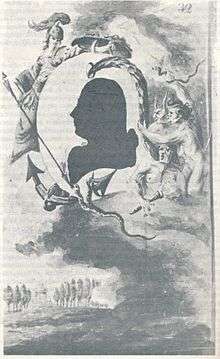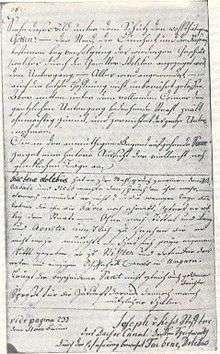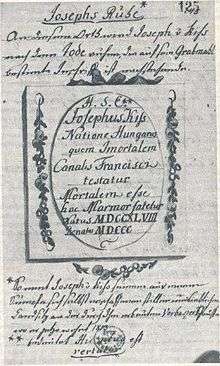József Kiss (engineer)
| József Kiss | |
|---|---|
 Self-portrait in his notebook | |
| Born |
19 March 1748 Buda, Habsburg Monarchy (modern-day Hungary) |
| Died |
13 March 1813 (aged 64) Sombor, Habsburg Monarchy, (modern-day Serbia) |
| Nationality | Hungarian |
| Fields | Hydrotechnical engineering |
| Known for | Great Bačka Canal |
József Kiss (Serbian Cyrillic: Јожеф Киш; March 19, 1748 – March 13, 1813) was a Hungarian hydrotechnical engineer. He is most famous for being the architect of the Great Bačka Canal, the most important hydrotechnical and transport object in Bačka. Later architects of the hydrosystem Danube-Tisa-Danube Canal based their work on his ideas and projects.
Biography
József Kiss was born in Buda on 19 March 1748. in a family of military officers, that obtained nobility status in 1681 with the predicate Kissarosi.[1] Together with his brother Gabor he graduated from the famous military academy in Vienna founded by Eugene of Savoy. After his student days, in 1768, he set off on a study trip to Great Britain, where the construction of a branched system of navigable channels had already begun.
Having returned to the Habsburg Monarchy, he was appointed for the job of military engineer for bridges. Soon after he abandoned military service, becoming a civil engineer in the 1770s working for the Hofkammer, the main financial institution of the Habsburg Monarchy. His first duty was regulating the water level of the Danube near Bratislava. Later he was moved to the outskirts of Vienna. He produced many important notes of watercourses.[2] Records mention him as a clerk of the Hofkammer around 1780.[1][3] In 1782, Joseph II initiated a new German colonization from southeastern regions of Germany to the Podunavlje. The main intention was to provide a solid economic basis for the migrating population. That is when József Kiss first came to Vojvodina.[1] However, a serious water supply problem was encountered: the southern edge of the Telek Highlands were covered with morasses, marshes, bogs and terrain infested with reed; and east of Vrbas lay the Crna bara ("black pools"), a water catchment area. Those lands were the natural habitat of mosquitoes, so even the rare people populating them were dying of malaria. Without drying out that terrain, colonization was impossible. On the proposal of Kiss in 1785, a discharge ditch one meter in width was dug between Kula and Vrbas for the purpose of underground streams drainage. The following year, a lengthier and deeper channel was dug between Sivac and Vrbas in order to drain a nearby bog.
In 1787, as soon as the Sivac - Vrbas channel was done, he measured out the terrain between the Danube and the Tisa on his own expense and determined that there is a 7.27 meter elevation difference. By that he concluded that topographical conditions for creating a channel between these two rivers via the Crna bara.
The Hofkammer made him in 1788 the leading engineer for Bačka (Dirigirender Hofkammer—Ingenieur). His duties were, among others, to supply the military with lumber from forests and to enable undisturbed navigation.
In the meantime, his younger brother Gabor arrived at Bačka. He cooperated with József on the project of the Great Bačka Canal until he was summoned to war.
Work

The Kiss brothers submitted an application to the brother and successor of Joseph II, the new monarch Leopold II, which in one part stated:
„The undersigned two brothers, guided by the aspiration to benefit their homeland take the courage to suggest to your royal highness most humbly the connection of the Danube near Monoštor with the Tisa near Bačko Gradište by the means of a navigable channel [...] The situation and plan of the level, accurately determined on their expense, show the possibility of creating such a channel, as well as its great possible benefit on commerce, factories, manufactures [...] and the benefit on the land quality in such a beautiful province.“[1]
They had received the license to build the channel and formed an association with the base capital of 800,000 forints in 1792. The association was called The privileged Hungarian shipping society. The work started in spring of 1793 under the supervision of József Kiss.
In the meantime, the government had been troubled by serious war problems. The construction continued albeit slowly. The number of engaged workers is not known, although it is known that there weren't enough of them. There was possibly about 2000 at the start, and fewer later on. Instead of the promised 4000 soldiers, the monarchy sent two regiments from Baja with the leadership of their officers to construct barracks, and with the aid of instruments scan the transverse profiles of the foundation pits for locks and channel sections. The same job was appointed to the Slovak soldiers who arrived in Bačko Gradište. Later on, when about 500 shackled convicts were brought to the site, they were required to guard and fiercely force them to work. Since the convicts were poorly dressed and badly fed, their performance was low, so they were pulled back some time later. Confronted with the need for more workers, József Kiss was forced to place notices around the monarchy offering good payment.[4] Difficulties came up already during the first year of works on the Monoštor lock. High water pressure of the Danube caused water to flow in the working pit and create sludge. Freshly built slopes frequently collapsed, and the biggest of problems was caused by the underground streams.
However, the works continued, so after four years, the channel was navigable to the point of Mali Stapar.
Following an anonymous notification in 1796 declaring that the channel was not being built as projected, that the works slow, that the expenses will exceed the agreed and fixed amount in the contract. Even though József Kiss gave reasonable explanations, he was expelled from the society, stripped of all functions in the association. It was a tough blow for him, mostly because the works were coming to an end, as well as losing all the money they invested in the channel, which led to their utter financial ruin.
Stanislav Hepe (Hungarian: Нерре Szaniszló) was appointed to continue the project from 1797 to 1801.
When it was finished in 1802, the Danube - Tisa channel had the length of 14 ½ Austrian miles (110 kilometers). This length is cited on all maps published after the completion of the channel.[5] The voyage from Bezdan to the Tisa was therefore shortened by 258 kilometers. That meant saving about 10 days traveling downstream, and about 20 days traveling upstream.
The stimulus that commerce, manufacture and navigation received influenced the enhanced development of the nearby settlements, such as Apatin, Sombor, Crvenka, Kula, Vrbas, Srbobran and Bečej. An important function of the channel was also melioration, especially east of Vrbas. The wide marshy terrain around the banks of the channel were drained and turned into fertile soil.
Epiloque

Stripped of all functions in the association, József Kiss at first returns to his job as the leading engineer for Bačka. When he finally retired, after 42 years of duty, he received only a quarter of his pension from the Hofkammer. Annually, that was about 312 forints. The other three quarters were excluded in order to repay his debt after the final breakdown with the association. He built a peaceful summer house near Vrbas, which he called Josephsruhe (József's peace). Here he spent his last days; he was also berried nearby on his own wish.
A notebook written in his hand, in German and Latin, was left after him. He titled it Stammbuch. It is mostly dedicated to his family, containing also sketches of famous historical figures of the 18th century, such as Maria Theresia, Joseph II and Napoleon Bonaparte. On the last page, he had drawn his wished gravestone, along with the epitaph for it, which stands to this very day on his grave, somewhat changed:
Here lays József Kiss, a Hungarian noble. He is immortal, for the Franz channel stands. He is mortal, for this cold marble. He was born in Buda 14 days before the April calends of 1748. He died in Sombor, among his friends from Bačka, on the third day of the March idas of 1813.
Importance
Being the architect and the first creator of the largest technical project in Podunavlje, he began the era of grand hydrotechnical works in that region. He was the predecessor and inspiration for many a generation of hydrotechnitians in the hydrographically complex region of Bačka.
References
- 1 2 3 4 Petrović Nikola; „Plovidba i privreda srednjeg Podunavlja u doba merkantilizma“; Istorijski institut; Beograd; 1978.
- ↑ Građa za proučavanje spomenika kulture Vojvodine XXIV i XXV“; Pokrajinski zavod za zaštitu spomenika kulture; Novi Sad Svetlana Bakić; „Ištvan Varga (Varga István): Istorijat kanala koji povezuje Dunav sa rekom Tisom (u XVIII i XIX veku)
- ↑ „Srpski biografski rečnik 5 KV-Mao“; Matica srpska, Novi Sad; 2011.
- ↑ „Andrejev Nikita; “Izgradnja i eksploatacija starih plovnih kanala u Bačkoj“; Javno vodoprivredno preduzeće „Srbijavode“, Beograd; Vodoprivredni centar „Dunav“, Novi Sad; 2002. ISBN 86-904957-2-X COBISS.SR-ID 197051399
- ↑ Nationalbibliothek, Kartensammlung, sign. C 2402—a